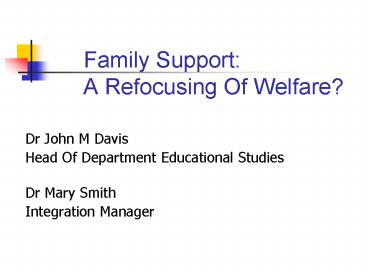Family Support: A Refocusing Of Welfare PowerPoint PPT Presentation
1 / 19
Title: Family Support: A Refocusing Of Welfare
1
Family SupportA Refocusing Of Welfare?
- Dr John M Davis
- Head Of Department Educational Studies
- Dr Mary Smith
- Integration Manager
2
Introduction
- Policy Background
- Policy in Practice
- Case Study of Family Support Service
- Negative Views Of New Service
- Positive Views Of New Service
- Family Support At A Crossroads
- Different Theories
- Conclusion No Easy Answers!
3
Policy Background
- 1998 New Community Schools Funding
- 2001 For Scotlands Children Report
- 2002 Childrens Change Fund
- 2003 Integrated Childrens Services within The
Local Authority - 2005 Getting it Right for Every Child in
Scotland - 2005 A Curriculum for Excellence
4
Policy Change Into Practice
- Setting up of Integration Teams
- Setting up of Locality Forums
- Different Professions within Childrens
Services working more closely together - Development of Role of Family Support Work
5
New Family Support Service?
- Degree Professional
- Developing Universal Targeted Services
- Leading Multi-Professional Working
- Change Agents and Boundroids
- Non Statutory Holistic Support
- Workforce Reform
6
Findings Family SupportNegative View
- Viewed as Para-Professional low-cost, low-skill,
support assistant - Tension - Preventative v Statutory
- Influenced by vested interest/politics
- No clarity on what role is or does
- Lacked a clear philosophy
7
Findings Family SupportPositive View
- Highly qualified staff
- Families/children saw an improved if imperfect
service - Local forums enabled joint working
- More appropriate assessment
- More rapid and appropriate responses
- Local capacity building
8
Family Support At A Crossroads
- Polarised debate about preventative v acute
intervention - Lack of Clear and Shared Theory To Underpin
Practice - More opportunities required for discussion of
different starting points to assessment and
provision
9
Ways ForwardBuilding A Theory
- Dolan (2006) Types, Qualities and Principles
- Gilligan (2000) Forms of Support
- Gilligan (2000) Parents Complex Identities
- Hill (2005) Gilligan (1999) Child Agents
- Davis (2006, 2007) Complex/Fluid
- Smith (2009) Small Change v Radical Leap
10
Dolan (2006) Social Support
- 4 Types concrete, emotional, advice and esteem
- 3 Qualities of social support Closeness,
reciprocity and durability (e.g. a reliable
person you have know for a long time). - Range of principles concerning partnership
minimum intervention clarity of focus
strength-based perspectives informal networks
accessible/flexible services self referral
inclusion diversity and best practice
11
Gilligan (2000) More Than A Child Protection
Service
- Mobilising support for where children live their
lives -Family, peer, school, sport team, church
etc - Child-focused supporting - social, psychological
educational development - Prevent child leaving family by reducing stress,
promoting competence, connecting child family
to support and resources
12
Gilligan (2000) Parents Have Complex Identities
- Multiplicity of roles and identities
- Isolated young mother , can also become some one
with good child care who is integrated into
community as a student worker, team mate,
football supporter - Key principle of family support is to enhance the
number of identities available - This may take time and require sensitivity
- The role of schools and education is very
important
13
Hill (2005) Gilligan (1999) Children Are
Complex
- Children can gain support from wide range of
adults and children - Relates to mobility and autonomy
- Notions of boundary of family not fixed - e.g.
reconstituted families - Children create their own identities
- Childhood is more regulated
14
Different Theories
15
Conclusion - Davis (2006 2007)
- Professional roles to be examined as much as
parents/childs - Labelling/deficit models - give
professionals/parents an excuse - No Single Theory Works in Its Totality -
individual, developmental, structural,
ecological, post-structural etc - MUD, SID, RED, SSD, SDD - challenges victims
discourse and realises that professionals can be
as much a part of the problem as the solution - Practitioners need to be reflexive and discuss
the pros and cons of different personal and
professional positions - This needs to include an understanding of power,
politics and vested interests
16
Conclusion - Smith (2009)
- Family Support Next 5-10 Years
- Status Quo
- Tinkering At Edges
- Radical Change
17
References
- Davis, JM (2006) Childrens Boundaries in McKie L
Cunningham-Burley S. (eds) (2005) Families in
Society Boundaries and Relationships. Bristol
The Policy Press - Davis JM (2007) Analysing Participation and
Social Exclusion With Children and Young People.
Lessons From Practice International Journal of
Childrens Rights 15(1)121-146.
18
References
- Hill, M (2005) Childrens Boundaries in McKie L
Cunningham-Burley S. (eds) (2005) Families in
Society Boundaries and Relationships. Bristol
The Policy Press - Gilligan R.(2000). Family support issues and
prospects. In Canavan J , Dolan P , Pinkerton J
(eds) Family Support Directions from Diversity.
London Jessica Kingsley Publishers.
19
References
- Gilligan, R. (1999) Working with Social Networks
Key Resources in Helping Children at Risk In
Hill, M. (ed) Effective Ways of Working with
Children and their Families. London Jessica
Kingsley - Smith, M (2009)

